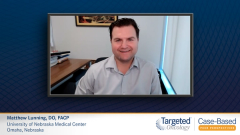
Chemorefractory Disease in Second-Line DLBCL Treatment
An expert explains the options for patients with DLBCL who develop chemorefractory disease in second-line treatment.
Episodes in this series

Case Overview: A 64-Year-Old Man with Diffuse Large B-Cell Lymphoma (DLBCL)
Case History
June 2020: A 64-year-old man presented with DLBCL
Stage III disease
ECOG PS 2
Serum LDH=3.7 x ULN
NCCN-IPI score=6 (High-risk)
History of hypertension (well-controlled)
Patient does not harbor MYC, BCL2, or BCL6 rearrangements
July 2020: Patient began treatment with RCHOP (rituximab, cyclophosphamide, doxorubicin, vincristine, prednisone) induction therapy
Patient had neutropenic fever and limiting fatigue that was controlled with growth factor support; also had mild neuropathy
Underwent interim CT scan after 3 cycles/9 weeks and again at completion of therapy (6 cycles/18 weeks)
Patient achieved a metabolic complete response at 18-week PET-CT scan
May 2021 (6 months post–RCHOP completion): the patient complained of recent weight loss, fatigue
Followup CT scan revealed that the patient had relapsed disease
Patient started salvage chemotherapy with R-GemOx (rituximab, gemcitabine, oxaliplatin)
Most Recent Follow-up Notes/Labs
November 2021: 6-month for-cause CT scan and subsequent biopsy revealed that the patient was refractory to GemOx
The patient lives 50 miles from a healthcare facility that administers CAR T-cell therapy and does not have reliable transportation or continuous caregiver support; he and his clinician decided to start 3rd-line tafasitamab/lenalidomide
April 2022: The patient remains on tafasitamab/lenalidomide; fatigue has mostly resolved
Matthew Lunning, DO, FACP: In second-line therapy, chemotherapy-refractory disease is much more common than we think, especially in the era of receiving rituximab as first-line therapy. I’d argue that responses amenable to going on to an autologous stem cell transplant account for maybe 20% to, at most, mid-30% of the patients. When you’re meeting a patient with second-line diffuse large B-cell lymphoma [DLBCL], the odds are that with chemotherapy-immunotherapy or platinum-based chemotherapy-immunotherapy, they’re more likely not going to obtain a response amenable to consolidative high-dose therapy and autologous stem cell transplant. Taking that away from other regimens that classically wouldn’t be used as a bridge or salvage therapy toward stem cell transplant in that transplant-ineligible population, I’d argue that the response rates are in the 30%-to-40% range, but you’re looking at a much lower complete remission rate.
The challenges include that we often want to ignore the history of their prior lines of therapy and how they tolerated it, because we were hoping that with subsequent therapies that we’d be able to tweak or fine-tune the chemotherapy regimen. But historically, in my experience, with patients who’ve had difficulties with prior lines of therapy with chemotherapy, giving chemotherapy again will often have the same or similar difficulties with chemotherapy. Even if you try to massage the regimen, they’re likely to still have similar issues, especially if those issues were more nondescript, like progressive fatigue or difficulty with cytopenias that allow them to continue on their second-line or beyond therapy as more on schedule.
One of the difficulties with aggressive non-Hodgkin lymphomas is that you want to keep them on schedule. What DLBCL and other aggressive lymphomas love is a break in therapy because of toxicity. The double whammy is when you have people who have aggressive lymphomas who are getting treatment delays and the odds of the chemotherapy being ineffective are quite high. They’re not only progressing through the therapy but also having toxicities to that ineffective therapy.
There’s a cadre of patients, a very small percentage of patients, who we consider as having primary refractory or primary progressing lymphomas. Those patients are rolling into immediate second-line therapy because they still have active disease. There’s a difference between patients who are typically relapsing within a year of their diagnosis or about a year from the end of first-line therapy. Those patients may not do as well.
We know from the SCHOLAR-1 data looking at primary refractory or relapsing, or those refractory to second-line therapies, that those patients do quite poorly with subsequent lines of therapy with overall response rates of 27% and CR [complete response] rates of 7% in CT-based response criteria. But the median overall survival in that population is around 6 months. I’d think that would be a population of interest. Even though some of us don’t do surveillance imaging, perhaps that’s why the NCCN [National Comprehensive Cancer Network] Guidelines allow surveillance imaging every 6 months for 2 years. But there’s a big difference between surveillance imaging and for-cause imaging, at least in my opinion.
Transcript edited for clarity.









































